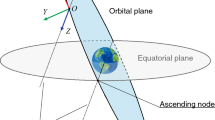Abstract
We propose a method that uses only one set of known orbital elements to directly determine the motion state and variation ranges of motion parameters, including the inclination, right ascension of the ascending node (RAAN), evolution period of the orbital plane, maximum libration amplitude of the semi-major axis, commensurable angle, libration period and drift period, for space debris in the geosynchronous ring. These variation ranges of motion parameters characterize the evolution of debris quantitatively and illustrate the three-dimensional (3D) variations. Employing the proposed method, we study the motion state and variation ranges of motion parameters for catalogued and uncontrolled space debris with existing two-line element (TLE) data in the geosynchronous ring, and present specific results. We also compare our results with actual observational results derived from long-term TLE historical data, and find that, in the vast majority of cases, our proposed method of determining the motion state and variation ranges of motion parameters via only one set of known orbital elements is effective. In addition, before the elaboration of the variation ranges of motion parameters stated above, we obtain the statistical distribution of space debris in the orbital plane and the daily motion from the TLE historical data. We then derive two mathematical formulae that explain the statistical distribution and daily motion on the basis of the essence of dynamics, which contributes to the characterization of the evolution of debris.









Similar content being viewed by others
Notes
TLEs data are distributed on the Internet at https://www.space-track.org.
References
Allan, R.R.: Perturbations of a geostationary satellite by the longitude-dependent terms in the Earth’s gravitational field. Planet. Space Sci. 11, 1325–1334 (1963)
Allan, R.R., Cook, G.E.: The long-period motion of the plane of a distant circular orbit. Proc. R. Soc. Lond. A 280, 97–109 (1964)
Anderson, P.V., Schaub, H.: Local orbital debris flux study in the geostationary ring. Adv. Space Res. 51, 2195–2206 (2013)
Anderson, P.V., McKnight, D.S., Pentino, F.D., Schaub, H.: Operational considerations of GEO debris synchronization dynamics. In: 66th International Astronautical Congress, IAC-15,A6,7,3,x27478, Jerusalern, Israel, pp. 12–16 (2015)
Blitzer, L., Boughton, E.M., Kang, G., Page, R.M.: Effect of ellipticity of the equator on 24-hour nearly circular satellite orbits. J. Geophys. Res. 67, 329–335 (1962)
Capelle, K.S., Sharma, J.: Geosynchronous satellite orbit pattern: improvements to SBV geosynchronous search. In: Proceedings of the 2000 Space Control Conference, pp. 29–42. MIT Lincoln Laboratory, Lexington (2000)
Chao, C.C.: Applied Orbit Perturbation and Maintenance. The Aerospace Press, El Segundo (2005). American Institute of Aeronautics and Astronautics
Chobotov, V.A.: Orbital Mechanics. American Institute of Aeronautics and Astronautics, Reston (2002)
Flohrer, T.: Classification of geosynchronous objects issue 15. In: ESOC (2013)
Flohrer, T.: Classification of geosynchronous objects issue 17. In: ESOC (2015)
Flohrer, T., Choc, R., Bastida, B.: Classification of geosynchronous objects issue 13. In: ESOC (2011)
Garfinkel, B.: Formal solution in the problem of small divisors. Astron. J. 71, 657–669 (1966)
Hernández, C., Jehn, R.: Classification of geostationary objects. Space Debris 1, 235–337 (2001)
Hoots, F.R., Roehrich, R.L.: Models for propagation of NORAD element sets. Aerospace Defense Command, United States Air Force, December (1980)
Inter-Agency Space Debris Coordination Committee: IADC Space Debris Mitigation Guidelines, IADC-02-01 (2002), revised (2007)
Krisko, P.H., Hall, D.T.: Geosynchronous region orbital debris modeling with GEO-EVOLVE 2.0. Adv. Space Res. 34, 1166–1170 (2004)
Samson, P.: Classification of geostationary objects User Guide. In: ESOC (1999)
Schildknecht, T.: Optical surveys for space debris. Astron. Astrophys. Rev. 14, 41–111 (2007)
Schildknecht, T., Musci, R., Ploner, M., Beutler, G., Flury, W., Kuusela, J., de Leon Cruz, J., de Fatima Dominguez Palmero, L.: Optical observations of space debris in GEO and in highly-eccentric orbits. Adv. Space Res. 34, 901–911 (2004)
Schildknecht, T., Flohrer, T., Musci, R., Jehn, R.: Statistical analysis of the ESA optical space debris surveys. Acta Astron. 63, 119–127 (2008)
Valk, S., Lemaître, A., Deleflie, F.: Semi-analytical theory of mean orbital motion for geosynchronous space debris under gravitational influence. Adv. Space Res. 43, 1070–1082 (2009)
Zhao, C.Y., Zhang, M.J., Wang, H.B., Zhang, W., Xiong, J.N.: Two-dimensional phase plane structure and the stability of the motion for space debris in the geosynchronous ring. Adv. Space Res. 52, 677–684 (2013)
Zhao, C.Y., Zhang, M.J., Wang, H.B., Xiong, J.N., Zhu, T.L., Zhang, W.: Analysis on the long-term dynamical evolution of the inclined geosynchronous orbits in the Chinese BeiDou navigation system. Adv. Space Res. 56, 377–387 (2015)
Acknowledgements
This research was supported by the Key Program of the National Natural Science Foundation of China (Grant nos. 11033009 and 11533010) and the National Science Fund for Distinguished Young Scientists of China (Grant no. 11125315). The authors would like to thank Dr. R. Jehn for providing useful literature, and thank anonymous reviewer for the valuable comments that helped to substantially improve the manuscript.
Author information
Authors and Affiliations
Corresponding author
Rights and permissions
About this article
Cite this article
Zhao, CY., Zhang, MJ., Yu, SX. et al. Variation ranges of motion parameters for space debris in the geosynchronous ring. Astrophys Space Sci 361, 196 (2016). https://doi.org/10.1007/s10509-016-2781-5
Received:
Accepted:
Published:
DOI: https://doi.org/10.1007/s10509-016-2781-5




